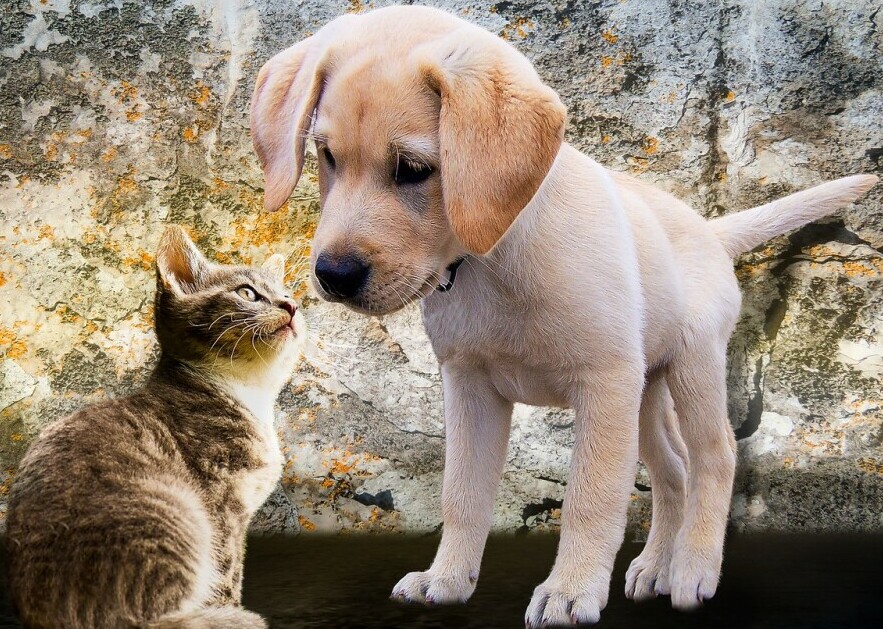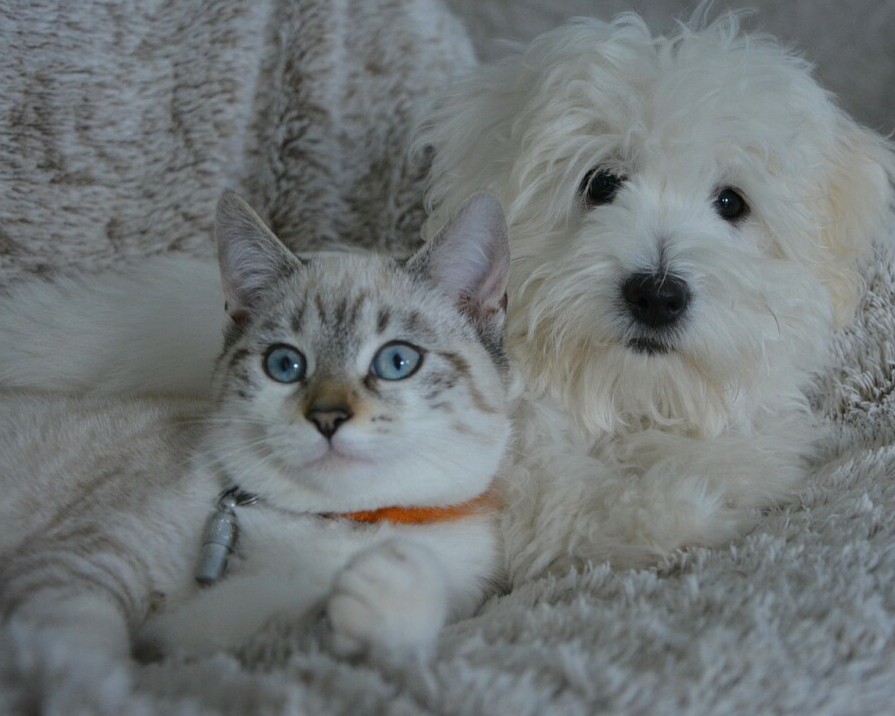Hi, it’s Bob here to share my experience when my Kitty first came into our home. She was a stray, and truth be told, I was a bit anxious about how she would fit in, especially with Puppy. Now, Puppy had run of the house for 12 years and had a rather firm belief that all felines were the enemy. Introducing a cat into her domain? A recipe for raised hackles, I thought.
I knew I had a delicate process ahead of me. Fast-forward a year and a half and the picture is quite different. They’re not exactly the furry version of Thelma and Louise, but we’re getting somewhere. Occasionally, Kitty, in her infinite feline wisdom, finds it amusing to fake an ambush on Puppy—who, to her credit, has learned to take these episodes with a certain stoic grace.
Turns out, Kitty has her own brand of humor, and I have to join in the laughter sometimes. A year and a half might seem long, but in the quest for household peace, it’s been a well-spent time. Now, I’m here to help you navigate this process, fully armed with the insights and tips that have seen me through.
Ready to learn how you can smoothly transition from a dog-only kingdom to a bipartisan pet regime? Let’s set the stage for a cat and dog symphony, minus the chaos. First up, it’s all about groundwork and it begins with something invisible yet powerful: scent. That’s going to include some clever strategies like scent swapping that I’ll unpack for you in the next section.
Preparing the Ground: The Art of Scent Swapping
Let’s start with the basics: before your new cat and resident dog see each other for the first time, it’s crucial to set the stage for a successful meet-and-greet. This is where the art of scent swapping comes in. Just as humans shake hands when they meet, cats and dogs use smell to get to know one another.
Here’s how to execute this scent introduction effectively. First, exchange their bedding. Place your dog’s blanket in the cat’s space and vice versa. This way, they’ll begin to become familiar with each other without the stress of a direct encounter. You can also rub a cloth on one pet and let the other sniff it. The goal is to make the scent of the other animal a common part of their environment.
This method is less about a big reveal and more about laying a familiar scent trail. By swapping toys or bedding regularly, you gently build a bridge of familiarity. It’s this bridge that can lead to positive associations when they finally do meet.
You’ll want to keep these scent-swapped items near their feeding areas or in their favorite resting spots. Why? Well, these are zones where your pets feel safe and content, which encourages them to link those positive feelings to the other’s scent.
Now, the success here doesn’t come overnight. Patience is your ally. Depending on your pets’ temperaments, this phase can last from a few days to a week or more. I had to play it cool for a while with Kitty and Puppy, and trust me, it pays off.

Creating Calm Encounters: Leash and Space Management
Once you’ve set the stage with scent swapping, it’s time to orchestrate the all-important introduction between your furry inhabitants. I’ll walk you through how to manage these first few encounters to pave the way for a peaceful household. Keep in mind, this isn’t just about getting through an introduction; it’s also about setting the tone for the long-term relationship between your cat and dog.
For the initial face-to-face, you’ll want to have your dog on a leash. This gives you control over their movement and protects the cat from any overenthusiastic greetings. Now, I’m not saying that every dog is going to lunge at your new cat, but it’s better to err on the side of caution.
Let the cat dictate the pace of this meeting. Cats are often more comfortable when they feel like they’re the ones in charge, and they’re more likely to approach if they don’t feel cornered. So, choose a neutral space where your cat can explore and approach the dog out of curiosity, rather than necessity.
I’ve found that safe spaces are a godsend. Whether a separate room or a cat tree that stands like a fortress, make sure that your cat has an escape route. A place to retreat to is vital for their sense of security. If you’re using a baby gate, make sure it’s high enough that your cat can jump over, but not so low that your dog considers it an invitation.
Keep a sharp eye on their body language. A stiff tail, flat ears, or growls from either pet means it’s time to intervene. Don’t be discouraged if this happens—remember, this is a process. As they grow more accustomed to each other, you can gradually increase the length of these controlled introductions.
Bonding Over Treats and Tricks: Positive Reinforcement
I’m going to show you the ropes of using positive reinforcement to help your cat and dog become, if not best buddies, at least amiable roommates. It’s a method that has worked wonders in my house.
Positive reinforcement isn’t just about giving treats, though this is a major part of it. Praising both your cat and dog when they behave calmly or show friendliness toward each other teaches them that good things happen in each other’s company.
Supervised playtime is a crucial part of this process. As things progress, allow your cat and dog to share the same space while you oversee. It’s important to use interactive toys that encourage them to play together or at least engage simultaneously side-by-side. This can often turn into positive interaction and over time, a bond can form.
Training is key to ensuring managed interactions, especially for your dog. Simple commands such as ‘sit’, ‘stay’, and ‘leave it’ can nip any overly excited behavior in the bud. In my experience, teaching Kitty to come when called – yes, cats can learn this too! – ensures I can quickly manage any situation that arises.
Remember, the speed at which you move through these steps should always be dictated by the comfort level of your pets. If it seems like things aren’t going as smoothly as expected, don’t be disheartened. You can always adjust your approach down the road.

Maintaining Harmony: Routine and Respect for Preferences
Remember, introducing a cat to a dog household is a marathon, not a sprint, and every animal has its own unique personality and comfort level. Consistency can be your best ally in helping both your cat and dog understand what’s expected of them and when. By setting a regular schedule for meals, playtime, and relaxation, you’re creating a stable environment that can reduce anxiety for both pets.
In my experience, it’s not just about meticulous planning but also about respecting the distinct tendencies of each animal. Some dogs and cats may never be the best of pals, but mutual respect can be achieved. If your cat prefers to watch the world from a shelf, and your dog is happy with the floor, that’s a peaceful coexistence worth celebrating.
The journey might be filled with funny antics, like Kitty’s ‘fake attack’ moves that seem to bring out her sense of humor. Approaching these interactions with patience and not pressing for a close bond lets pets interact in their own time and way. If a strong friendship blossoms, that’s wonderful, but even a simple, stress-free cohabitation is a victory in itself.
Stay observant and be ready to tweak your approach if necessary. Animals can be pretty unpredictable, so don’t be discouraged if you need to make adjustments. Just like Puppy and Kitty, your dog and new cat have the potential to adjust to each other’s presence, and with thoughtful guidance, they can thrive in a shared home.
In closing, I’m Bob, and I’ve shared both my struggles and successes. It’s your genuine care and commitment that will ultimately craft a serene and happy household for both your new cat and your seasoned dog. Take it one day at a time, and may your furry friends find their own unique way to get along. Remember, as they grow accustomed to one another, so will you—finding joy in their shared moments and the individual quirks that make them your beloved pets.
